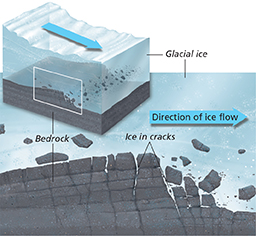Glacial Erosion and Deposition
Though glaciers move much more slowly than rivers, they are very effective at eroding and depositing sediment. This is because glaciers tear away the underlying rock as they move. Glaciers erode rock through abrasion and plucking. In plucking, shown in Figure 19, glacial ice widens cracks in bedrock beneath the glacier. Pieces of loosened rock are then frozen to the bottom of the glacier, which carries them away. The pieces of rock that are stuck to the bottom and sides of the glacier act like sandpaper. As the glacier moves, it scrapes the bedrock and soil under it and along its sides.
Figure 19 As a glacier moves downhill, it loosens and lifts pieces of rock from the ground underneath in a process known as plucking. Predicting What evidence of plucking would you expect to find after a glacier has melted?
 dd
ddFeatures Formed by Glacial Erosion
 Glaciers cause many distinctive features in the landscape, including cirques, horns, U-shaped valleys, and glacial lakes. Valley glaciers cause erosion high in the mountains where such glaciers begin. For example, a glacier can carve large bowl-shaped valleys out of a mountainside. These valleys, called cirques, look as if they were made by a giant ice cream scoop. If several cirques form close together, a ridge may be left between them. If several ridges connect to form a pyramid-shaped peak, the peak is called a horn. The peaks in the Swiss Alps, including the famous Matterhorn, were sculpted by glaciers. Figure 20 shows several of these features.
Glaciers cause many distinctive features in the landscape, including cirques, horns, U-shaped valleys, and glacial lakes. Valley glaciers cause erosion high in the mountains where such glaciers begin. For example, a glacier can carve large bowl-shaped valleys out of a mountainside. These valleys, called cirques, look as if they were made by a giant ice cream scoop. If several cirques form close together, a ridge may be left between them. If several ridges connect to form a pyramid-shaped peak, the peak is called a horn. The peaks in the Swiss Alps, including the famous Matterhorn, were sculpted by glaciers. Figure 20 shows several of these features.
Figure 20 The distinctive landscape near Mount Robson in British Columbia, Canada, was formed by glaciers.





